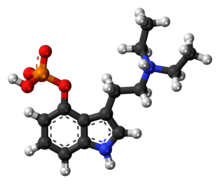This article needs additional citations for verification. (March 2009) |
 | |
 | |
| Clinical data | |
|---|---|
| Other names | 4-Phosphoryloxy-N,N-diethyltryptamine; CEY-39; 4-phosphoryloxy-DET; 4-PO-DET |
| ATC code |
|
| Legal status | |
| Legal status | |
| Identifiers | |
| |
| CAS Number | |
| ChemSpider | |
| UNII | |
| CompTox Dashboard (EPA) | |
| Chemical and physical data | |
| Formula | C14H21N2O4P |
| Molar mass | 312.306 g·mol−1 |
| 3D model (JSmol) | |
| |
| |
| (verify) | |
Ethocybin (CEY-19; 4-phosphoryloxy-DET; 4-PO-DET) is a homologue of the mushroom alkaloid psilocybin, and a semi-synthetic psychedelic alkaloid of the tryptamine family. Effects of ethocybin are comparable to those of a shorter LSD or psilocybin trip, although intensity and duration vary depending on dosage, individual physiology, and set and setting.[1][2]
- ^ "NCATS Inxight: Drugs — 4-PHOSPHORYLOXY N,N-DIETHYLTRYPTAMINE". drugs.ncats.io. Retrieved 2020-01-22.
- ^ Gartz J (1989). "Biotransformation of tryptamine derivatives in mycelial cultures of Psilocybe". Journal of Basic Microbiology. 29 (6): 347–52. doi:10.1002/jobm.3620290608. PMID 2614674. S2CID 43308695.